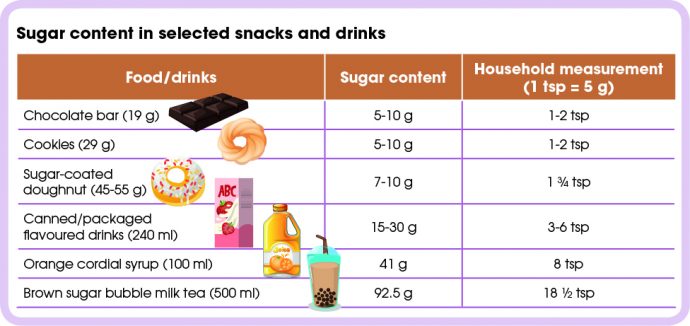Alarming numbers! 11.8% of children below 18 years old were obese in the National Health and Morbidity Survey 2015, and 1.65 million schoolchildren are expected to be overweight or obese by 2025 if nothing is done to mitigate the issue.
Children (and even adults!) are drawn to sweet foods and drinks, hence there are many shops serving sugar-loaded drinks and foods such as bubble tea and desserts. However, we tend to consume these excessively and frequently, which can lead to unhealthy consequences in the long run.
Sugar is the simplest form of carbohydrates and provides energy for our body to function, but it has no other nutrients on its own. Two forms of sugar can be found in foods: extrinsic and intrinsic. Extrinsic sugar is to enhance the flavour or for technical functions. On the other hand, intrinsic sugar is natural sugar found in fruits, vegetables and milk products.
Effects on health
Overconsumption of sugar leads to unnecessary calorie/ energy intake. The excess calories that are not burned off become fat in the body. This is one of the factors for the high prevalence of overweight and obesity problems in Malaysia, which leads to the increasing number of chronic non-communicable diseases (NCDs) such type 2 diabetes and coronary heart disease.
Frequent sugar consumption also plays a major role in dental caries development. This happens when bacteria on dental plaque react with sugar in foods or drinks to produce acids that gradually dissolve tooth enamel. Furthermore, studies also found that a diet high in sugar may reduce the intake of micronutrients in children.
Factors for obesity
Overweight and obesity are caused by excessive calorie intake coupled with sedentary lifestyle. Excessive calorie intake can occur with overconsumption of sugar, as well as with high intake of fatty, fried and oily foods and overconsumption of carbohydrate foods.

Less is better
Follow these key recommendations to control your family’s sugar consumption.
- Less sugary foods. Swap cakes, biscuits and ice cream for healthier options like fresh fruits, steamed corn and groundnuts. When having desserts and kuih, choose varieties with less sugar, cream and icing. Have smaller portions of dessert and limit intake to not more than once a day. Take note that savoury foods may also contain sugar.
- Less sweet drinks. Opt for plain water or milk, not sugar-sweetened beverages, to accompany main meals and to quench thirst between meals or before bedtime. Choose plain milk, soy milk or cultured milk with less sugar. Note that fruit juices contain high amounts of sugar and over consumption should be avoided.
- Choose sugar-free or lower sugar products. During grocery shopping, read the nutrition information panel on the labels and compare with other products. Check the list of ingredients for sugar and its other names such as sucrose, corn syrup or caramel. If any of these are listed at the beginning, it means sugar is one of the main ingredients. Choose products with the “sugar-free” or “less sugar” label.
- No sweet tooth. Avoid giving sugary foods or drinks to children below 1 year, so they will not develop a preference for sweet foods Use less sugar in food preparation and when cooking. Also try not to give sweet snacks as treats or rewards to children.
We must practise the recommendations and teach the importance of healthy eating to our kids. Parents play a key role in making healthier food choices for themselves and their family members. Choose foods and meals that are low in sugar, salt, fats and oil, and opt for more fruits, vegetables and whole grains. Consume balanced meals and always eat moderate amounts. Remember that healthy eating is not just reducing or cutting out any single food or nutrient. Healthy eating is a package.
An educational contribution by Nutrition Society of Malaysia.






Comments